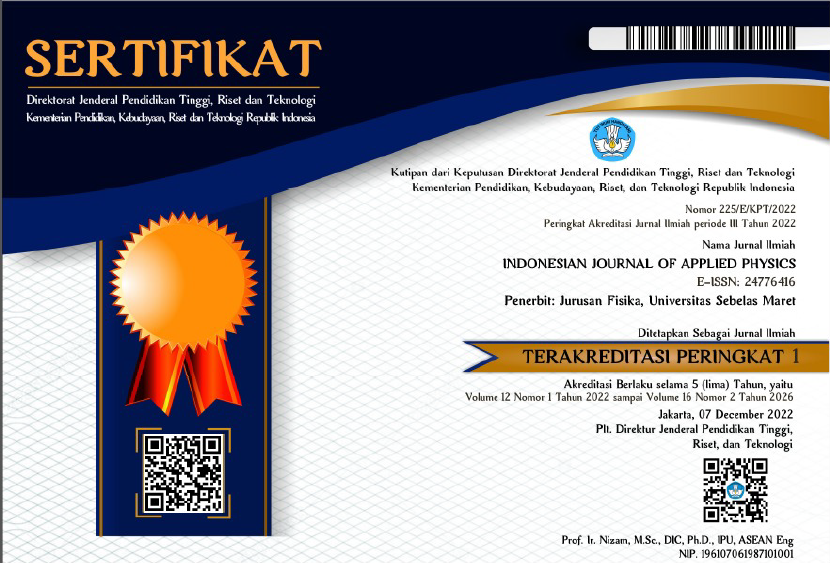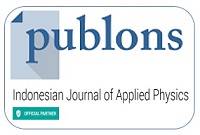Estimation of Tsunami Hazard and Evacuation Sites using The Cornell Multigrid Couple Tsunami Method in South Button Regency
Abstract
The 1992 earthquake and tsunami in the Flores Sea proved that the tsunami impacted the people of the South Buton Region. This research aims to map tsunami hazards and estimate evacuation routes and sites in the South Buton Regency. These evacuation routes and sites are very crucial for disaster preparedness and reducing the risk of tsunami disasters. This research simulates the tsunami wave hazard from the 1992 Flores earthquake using the Cornell multigrid coupled tsunami (COMCOT). We designed the study area in five layers and seven sublayers, encompassing 13 villages on the coast of South Buton Regency. The research generated seven tsunami hazard maps based on the number of existing sublayers, each equipped with evacuation routes and locations. In general, the seven study areas have two tsunami hazard levels: a hazard level with an inundation height of less than 0.5 m and a hazard level with an inundation height of 0.5–3 m. The tsunami inundation distance for the height of 0.5-3 m varies. The shortest inundation distance is 5–33 m in Lakambau and Laompo Villages, while the farthest distance is 57–98 m in Katampe, Lamaninggara, and Molona Villages. Apart from that, the tsunami wave arrived around 35–45 minutes after the earthquake. The fastest arrival time is 35 minutes in Bahari Village, which is closest to the source of the tsunami. The results of the study recommend 17 temporary evacuation sites (TES) and 7 final evacuation sites (FES) in the research area.
Keywords
Full Text:
PDFReferences
REFERENCES
1 Safani, J., Ibrahim, K., Wa Deni, Al Rubaiyn, Firdaus, & Harisma. 2023. Interpreting structural configuration of the Sengkang Basin of Indonesia using edge detection and 3-D Euler deconvolution to satellite gravity data. Turkish J Earth Sci., 32: 894-914.
2 Triyono, R., Prasetya, T., Daryono, Anugrah, S. C., & Sudraja, A. 2019. Katalog Tsunami Indonesia Tahun 416-2018. Badan Meteorologi, Klimatologi, dan Geofisika, Jakarta.
3 Benazir & Oktari, R.S. 2024. Assessing tsunami risk along the Aceh coast, Indonesia: a quantitative analysis of fault rupture potential and early warning system efficacy for predicting arrival time and flood extent. Natural Hazards. https://doi.org/10.1007/s11069-024-06401-x.
4 Magdalena, I., Rif’atin, H. Q., Kongko, W., Marta, A. S. D., Khoirunnisa, H., Nurwijayanti, A., & Farid M. 2024. Aceh's tsunami wave evolution and its interaction with hybrid protection structure. Physics of fluids, 36(2).
5 Muzani, Mataburu, I., Tafiati. 2024. Vulnerability and tsunami disaster on the west coast Banten province, Indonesia. All Earth, 36(1), 1-12.
6 Zuliansah, A. B. R., Windujati, U., Rasyif, T. M., Mahlil, T., & Januriyadi, N. F. 2023. Performance Evaluation of DualSPHysics and COMCOT Programs through Numerical Testing for Simulating Tsunami Propagation and Overtopping on Seawalls. E3S Web of Conferences 447, 01014.
7 Ario, F., Pratama, C., Adipura, D. T. R., Rasyif, T. M., Mahlil, T., & Januriyadi, N. F. 2023. Building Vulnerability Analysis Due to Tsunami by Using Probabilistic Tsunami Hazard Assessment (PTHA): A Case Study of Pelabuhan Ratu, Sukabumi. E3S Web of Conferences, 447, 01003.
8 Pranantyo, I. R., Heidarzadeh, M., & Cummins, P. R. 2021. Complex tsunami hazards in eastern Indonesia from seismic and non-seismic sources: Deterministic modelling based on historical and modern data. Geosci. Lett., 8, 20.
9 Paskett, T., Whitehead, J. P., Harris, R. A., Ashcraft, C., Krometis, J. A., Sorensen, I., & Wonnacott, R. 2024. A tale of two faults: statistical reconstruction of the 1820 Flores Sea earthquake using tsunami observations alone. Geophys. J. Int., 237, 419–435.
10 Pranantyo, I. R., Cummins, P. R. 2019. Multi-Data-Type Source Estimation for the 1992 Flores Earthquake and Tsunami. Pure Appl. Geophys, 176, 2969–2983.
11 Horspool, N., Pranantyo, I., Griffin, J., Latief, H., Natawidjaja, D. H., Kongko, W., Cipta, A., Bustaman, B., Anugrah, S. D., & Thio, H. K. 2014. A Probabilistic tsunami hazard assessment for Indonesia. Natural Hazards and System Earth Sciences, 14, 3105-3122
12 Pribadi, S., Hakim, M. L., Fauzi, Kurniawan, T., Nugraha, H. A., Daryono, Karnawati, D., Adi, S. P. 2023. The Mount Anak Krakatau landslide scenario for tsunami modeling in Banten. E3S Web of Conferences, 46418, 010102. 2nd International Conference on Disaster Mitigation and Management.
13 Wang, X. 2009. User Manual for COMCOT Version 1.7. Cornell University, USA.
14 UNESCO. 2016. Tsunami Glossary. Intergovernmental Oceanographic Commission (IOC) Technical Series, UNESCO, Paris.
15 Syamsidik, Rasyif, T. M., & Kato, S. 2015. Development of accurate tsunami estimated times of arrival for tsunami-prone cities in Aceh, Indonesia. International Journal of Disaster Risk Reduction, 14(4), 403-410.
16 Rasyif, T. M., Kato, S., Syamsidik, & Okabe, T. 2019. Numerical simulation of morphological changes due to theb2004 tsunami wave around Banda Aceh, Indonesia. Geosciences, 9(125), 1-16. https://doi.org/10.3390/geosciences9030125.
17 Kotani, M. (1998). Tsunami run‐up simulation and damage estimation using GIS. P. Coast. Eng., JSCE, 45, 356-360.
Refbacks
- There are currently no refbacks.
















